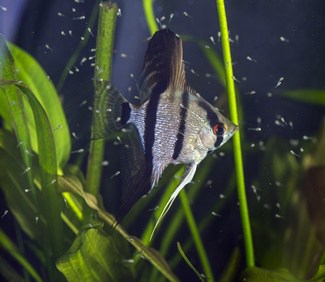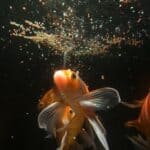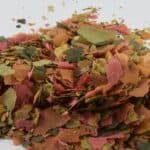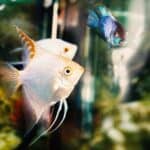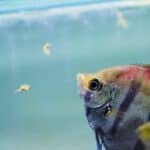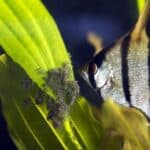Angelfish fry are so small and delicate that only certain foods are suitable for them. Baby brine shrimp and micro worms, for example, are small organisms and full of vital nutrients. This allows the tiny mouths of the fry to handle the food. It also gives them the resources necessary to grow to a large size at a rapid pace.
Baby brine shrimp, vinegar eels, and micro worms are the best foods for angelfish fry. These can be fed as soon as the fry reach the free-swimming stage. Prior to this, fry are sustained by their remaining yolk sacs and do not need to be fed. Once the fry are prepared for meals, they will need to be fed 2-4 a day.
Commercial fry foods are available, but you can use hard-boiled egg yolk slurries if live food is limited. To increase the odds of your delicate angelfish fry surviving, provide them with a varied diet. Choose more than one type of live food, and avoid frozen or dried kinds. As soon as the fry are free-swimming, offer a meal, since the tank’s natural infusoria cultures won’t sustain them for long.
What Do You Feed Baby Angelfish?
Angelfish fry are very small when they first hatch. Don’t mistake this tiny size for a tiny appetite. Angelfish fry need lots of nutrient-packed food, provided in multiple feeds each day. Rich, high-quality food is essential for increasing the number of fry that survive.
Experienced angelfish breeders maintain cultures of various foods to ensure that angelfish fry remain healthy. These include:
- Brine shrimp
- Vinegar eels
- Micro worms
Although cultures can be quite pungent, they allow you to produce high-quality food easily. In the early days of free-swimming, fry can only eat freshly hatched brine shrimp and micro worms. Anything else, including older shrimp and worms, are too big.
Can Angelfish Fry Eat Frozen Food?
Frozen options aren’t as nutritious or ideal in the first few weeks. They will suffice if that is all that you can source. The same applies to other commercially-available foods designed for fry at all stages. Be sure to thaw or pre-soak them before feeds.
If you want to offer a varied diet, or can’t find food small enough for baby angelfish, use:
- Hard-boiled egg yolks
- Egg yolk powder
When Do Angelfish Fry Start Eating?
Angelfish fry are sustained by their still-attached yolk sacs for the first week of life. In a way, they are eating from the moment they hatch.
Fry begin eating external food sources toward the end of this first week. This is when the yolk depletes and the fry must rely on food provided by yourself, or by natural cultures in the tank.
Will Angelfish Feed Their Fry?
Angelfish parents will protect their eggs and fry with a single-minded drive. They will not, however, provide food for their young. Unlike some species of fish, angelfish make their babies fend for themselves.
You may see the adult pair hovering over their fry as they become free-swimming and begin searching for food. This is a protective instinct, not the adults guiding fry to food sources.
Be aware that if you reach into the tank to feed the fry, the parents will attack you. It can be startling, especially if your angelfish usually respond in a more friendly way.
Unlike other cichlids, the teeth of the angelfish are located in their throat, not their jaws. Their bites won’t hurt overly much.
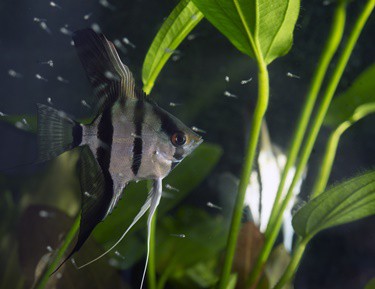
Will Angelfish Eat Their Fry?
Parent angelfish can eat their own young. This may be the result of stress or confusion. They may also eat a few of their eggs before they hatch. This is a natural behavior, serving as a way for the parents to remove dead eggs from the clutch.
It’s also very common for other fish in the tank to devour the fry. Even placid corydoras won’t pass up the chance to gobble up an isolated fry. Because of this, many people offer angelfish pairs their own tank for breeding.
If the eggs have been laid on a small object you can move, you can attempt to place it in a fry net before the little ones hatch. This will allow you to feed them separately and avoid new parents gobbling up the young.
When To Feed Free Swimming Angelfish Fry
At first, newly-hatched fry sustain themselves on their remaining yolk pouch. The name given to fry at this stage is ‘wrigglers’, as they will wriggle in place for roughly 4 days. You do not need to feed fry during this stage. The yolk provides a complete diet.
Once fry become free-swimming, they will detach from the nesting surface. For another 1-2 days, their yolk pouch will keep them sustained. However, you can begin feeding fry as soon as they are free-swimming. Do not wait any longer than a day or so before feeding. This can lead to massive die-offs, as these delicate fry perish quickly.
Angelfish grow at a rapid pace. To fuel such growth, they need to eat high-quality food multiple times a day. This amount should increase if they aren’t confined to a nursery tank and have to compete for food. Pipette droppers can be useful for ejecting water laden with food close to fry, giving them first dibs.
How Often Do Angelfish Fry Need To Be Fed?
Angelfish fry need to be fed multiple times a day. In breeding tanks free of competition, an ideal number is 3-4 feeds per day. Spread these throughout the day, so that the fry have food near-constantly in their bellies.
Every clutch will be slightly different and may thrive more on different feeding regimens. At the minimum, all fry clutches should have 2 feeds a day.
If you can only do a morning and night feed, offer the fish slightly more food. If you are able to feed them 3 or more times a day, slightly decrease the amount in each feed. Fish will over-eat very easily. Be sure to remove any uneaten food to stop it from rotting in the water.
At 3-4 months of age, the fry will have become juveniles and you can settle down to 2 feeds a day. Revista Brasileria de Zootecnia found that twice-daily feeds were optimal for healthy growth in juvenile angelfish. These feeds also prevent over-eating.
Feeding Baby Angelfish Fry
Angelfish fry are delicate life forms. They will die very easily, and certain foods increase their odds of survival in these early days and weeks.
As small creatures, fry will also struggle to fit certain types of food in their mouth. You need to pick the meals carefully. Here are the best options for different stages of life:
Pre-Made Food
Adult and juvenile angelfish can happily have pre-made foods comprise the bulk of their diet. These foods include:
- Flakes
- Pellets
- Freeze-dried options
Young fry, on other hand, cannot eat this. The nutritional value of dried foods is not high enough to meet their needs. Likewise, the food is too large for their mouths.
Once fry are over a month old, you can begin incorporating pre-made foods into their diet. These foods should only compose a quarter of their diet. Live or frozen foods should fill the rest.
Pellets
Owners are spoiled for choice when it comes to pellet foods. Hikari First Bites and Aquamunch are two options designed specifically for feeding fry, with the former being tailored for carnivorous fish.
These foods are nutrient-rich and made for fry, even those that are freshly hatched or born. Although these products can be a complete diet, it is best to include them as part of a varied diet.
Angelfish fry, babies, and juveniles can be fed these foods. At the later stages, however, they will be too small for the fish.
Crushed Flake Food
Flake foods are designed to float at the surface. That makes them unsuitable for fry and young angelfish. Adults can be fed flake foods, as can juvenile angelfish over 3-4 months of age.
Flake foods are often labeled as a complete diet for any fish. They can be. However, if you are trying to encourage your angelfish to breed, offer them high-quality foods alongside flakes. This enables larger clutches of healthy eggs to be laid.
You can finely grind up flake food in emergency food-shortages and mix it with water to create a slurry. This is not suitable as a regular part of a fry’s diet, and should only be used rarely in between live culture foods. For example, if your brine shrimp culture isn’t yet large enough to be used for multiple feeds each day, choose the slurry.
Live Foods
Live foods are the best type to offer carnivorous or omnivorous fish at any stage. Angelfish fry benefit from having live foods, especially in their first weeks of life.
Scientific studies have even proved this, with Revista de Biologia Tropical finding that live foods over commercial options are better for growing angelfish. Live foods must still be a certain size for very young fry.
Brine Shrimp
Brine shrimp are the top-recommended food for angelfish fry. They are highly nutritious. Freshly hatched brine shrimp are perfect for angelfish fry, even in the earliest days.
You can scoop up the brine shrimp with a pipette, spoon, or shot glass and tip them directly into the tank. A pipette is the best option if there are other fish in the tank, as you can disperse the shrimp directly over the fry.
Aquarium shops occasionally maintain their own brine shrimp breeding setups. This allows you to buy newly hatched shrimp as needed. You can also set up your own brine shrimp culture, which many breeders will do out of convenience and to save on costs.
You can even order brine shrimp eggs. There are many hatchery kits and a variety of DIY setups. Brine shrimp are quite popular as a food item, and freeze-dried and frozen options are available. Some nutrition is lost in this preparation process, but they are still good options.
Infusoria
Infusoria is a name given to the micro-organisms that live in bodies of water. These organisms include:
- Algae
- Euglena
- Amoebas
- Stentor
In the wild, these little critters are what angelfish fry eat. In your fish tank, the same will occur if any exist.
However, the infusoria population in your tank is rarely large enough to sustain the fry. For this reason, many aquarists will maintain an infusoria culture.
This is a great food source for newly hatched angelfish fry, as the organisms are tiny and nutritious. It is quite simple to develop this culture, although often unpleasant due to the odors produced.
- Take a sample of your aquarium’s water and place it in a larger food container.
- Add a food source, like yeast, and set the container in a sunny spot.
- After a few days, the water will hopefully become cloudy with micro-organisms.
- Extract and provide meals to the fry in the same way you would for brine shrimp.
Bloodworms
Bloodworms for freshwater angelfish are often the larvae of midge-flies. In the wild, many critters feast on these worms, including angelfish. Adult angelfish love live bloodworms, and young angelfish will happily scoop up small worms.
Bloodworms are occasionally sold live, but are most easily available in freeze-dried and frozen forms. No matter the form, bloodworms should only be given to juvenile or older angelfish.
Even then, bloodworms should be given to them 1-2 times a week, as this food can cause constipation. Bloodworms are not suitable for fry.
Micro Worms
Unlike bloodworms, micro worms are suitable for angelfish fry. You can even set up a culture so that you have tiny, nutritious worms as needed.
Micro worm cultures are widely available and very easy to set up and maintain. All you need are:
- A container
- Yeast and instant oats
- A starter culture
Worms are ready for harvest in 2 weeks, so you’ll need to have this prepared in advance. Micro worms are a great live food for fry and young angelfish.
Vinegar Eels
In spite of the name, vinegar eels are actually tiny roundworms, and not the parasitic kind. They’re:
- Easy to culture
- A great food source for fry
- Can survive in the aquarium for a day
As such, all the fry have a chance to eat at every meal, not just those that reach the table first. It also means the odds of leftovers rotting in the aquarium are minimal.
Even fish too small for baby brine shrimp can suck vinegar eels down easily. Live cultures are easy to DIY, and you can buy starter cultures in a variety of places. Wine bottles, or any container with a long, thin neck, are ideal.
Eels take roughly 2 weeks to grow to a harvestable age. As such, this is a culture you’ll need to prepare in advance. When they are ready to harvest, you can remove them from the vinegar culture before offering them to your fry. This is because the culture liquid is toxic to all fish.
To extract vinegar eels, stuff a cotton ball into the neck and top the bottle off with an inch or so of aquarium-safe water. Overnight, the eels will wriggle through the cotton to reach the fresh water. Use a pipette to suck up the eels and feed them to your angelfish fry.
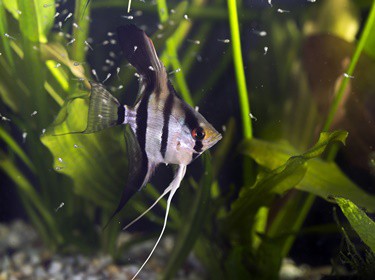
Do Angelfish Fry Eat Algae?
Angelfish fry will eat algae, alongside other infusoria. These are an omnivorous species, however, and algae alone will not be a complete, nutritious diet.
Green water cultures can be useful if you want to breed herbivorous fish alongside angelfish fry. You can also feed your brine shrimp cultures with green water.
- Create a green water culture by filling a clear container with aquarium water.
- Place this container somewhere with lots of direct sunlight.
- In a few weeks’ time, you’ll likely have a thriving algae culture.
- Extract the algae as needed and feed it to your fish or other culture critters.
Angelfish can eat algae at any age, including as new fry.
What Do Angelfish Fry Eat In The Wild?
In the wild, angelfish fry will eat whatever they can fit into their mouths. This includes micro flora and fauna, like algae, micro worms, and other tiny invertebrates.
Angelfish have such large clutches to increase the odds of some individuals reaching adulthood. The wild waters angelfish natively live in are full of dangers. Only a small percentage of fry will survive long enough to reach adult size.
Homemade Food For Angelfish Fry
Aside from live cultures, there are two types of homemade foods you can whip up for your angelfish fry. These are great for feeding unexpected clutches, or those that need food before your live cultures are ready to harvest.
It is best two intersperse other food sources throughout these homemade options. Also note that these foods can quickly foul the water. You’ll need to do frequent water changes and remove any uneaten food from the tank to minimize this.
Hard-Boiled Egg Yolks
Hard-boiled egg yolks are a great homemade food for angelfish fry. You can prepare this in advance or as needed, and store leftovers in the fridge for 2-3 days. To prepare this food:
- Cook the eggs for 7-9 minutes in gently boiling water.
- Allow the eggs to cool completely before separating the yolks from the whites.
- Mash the yolks into a powder.
- Add a small amount of your aquarium’s water to a portion of this powder and create a slurry.
- You can also get egg yolk powder to create a slurry.
For fry, you want this slurry to be liquid enough that it can be sucked into a pipette. This will make it easier to disperse the food near the fry, so none goes to waste. Once the fry are over a month old, you can add ground-up fish flakes to the slurry for added nutrition.
There are commercial foods made specifically for fry fish. However, these do not pack the same punch as live baby brine shrimp, micro worms, or vinegar eels – the best foods for fresh fry.
As the fish mature over a few weeks, commercial foods can be integrated into their diet. There is always the option of creating hard-boiled egg yolk slurries for an emergency feed too.

